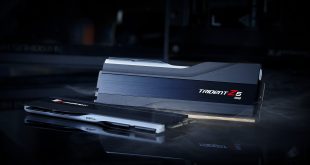The speed of a modern CPU is such that the more bandwidth you feed it, the better the results you get. So the question becomes, just how far can modern memory be pushed? Working in tandem with AMD and one of the world's top overclockers, ADATA has pushed the boundary back a little more. KitGuru pulls out a stop watch, pen and paper.
Many of the world's systems are probably still using antiquated DDR2 with speeds around 533MHz or even 800MHz. Sad really.
The move to DDR3 has been fast – matched only by the increases in frequency from the DDR3 module makers themselves.
While most performance rigs ship with 1600MHz memory, recent price drops have meant that 1866, 2000 and even faster RAM is now attracting enthusiasts on a sensible budget. Looking across the major resellers like Scan, Dabs, eBuyer and Overclockers – we see that 2400MHz is around the upper limit of ‘sensibly priced'.
But overclockers are an evil bunch. Just cos it says 2400MHz on the packaging, doesn't mean that it will be allowed to enjoy a long life and grow old at that speed. So how fast can you go with a pair of ADATA XPG 2400MHz modules in a Bulldozer platform?

If you're Matthias Zronek (aka ‘Mat' from Austrian torture specialists overclockers.at), then you can smash the overall DDR3 memory clock world record, by raising the bar up to 3312 Mbps using non-preselected, retail ADATA XPG Gaming Series V2.0 modules paired with an AMD FX-8150 Bulldozer CPU and an ASUS Crosshair V motherboard.

It's an impressive feat, but you should not expect to see 3300MHz RAM in PC World any time soon. This is a highly controlled environment. for now, but that's not to say that we won't have packets of >3,000MHz modules on sale in the (sort of) near future.

KitGuru says: Adding 3,300MHz modules to a slow system wouldn't make much difference, but when your multi-core CPU is kicking along at LN2 temperatures/speeds, then you need to feed the beast as fast as possible.
Comment below or in the KitGuru forums.
 KitGuru KitGuru.net – Tech News | Hardware News | Hardware Reviews | IOS | Mobile | Gaming | Graphics Cards
KitGuru KitGuru.net – Tech News | Hardware News | Hardware Reviews | IOS | Mobile | Gaming | Graphics Cards



I’m no expert but i would like to ask if he did any benchmark per say? The Core i7 3960X has 40 GB/s of stream memory bandwidth stock clocked. How does the OCed RAM improves the stream memory bandwidth for bulldozer? Stock it seems it’s ~20 GB/s according to Tech Report’s review (page 5) of the 3960X..
Very cool. I have these exact modules….Helped make my aggressively overclocked 1100t start to scare my stock 2600k in benchmarks 😀